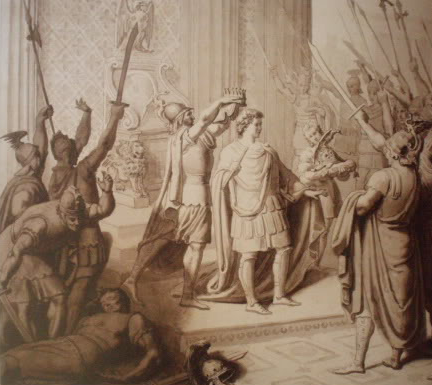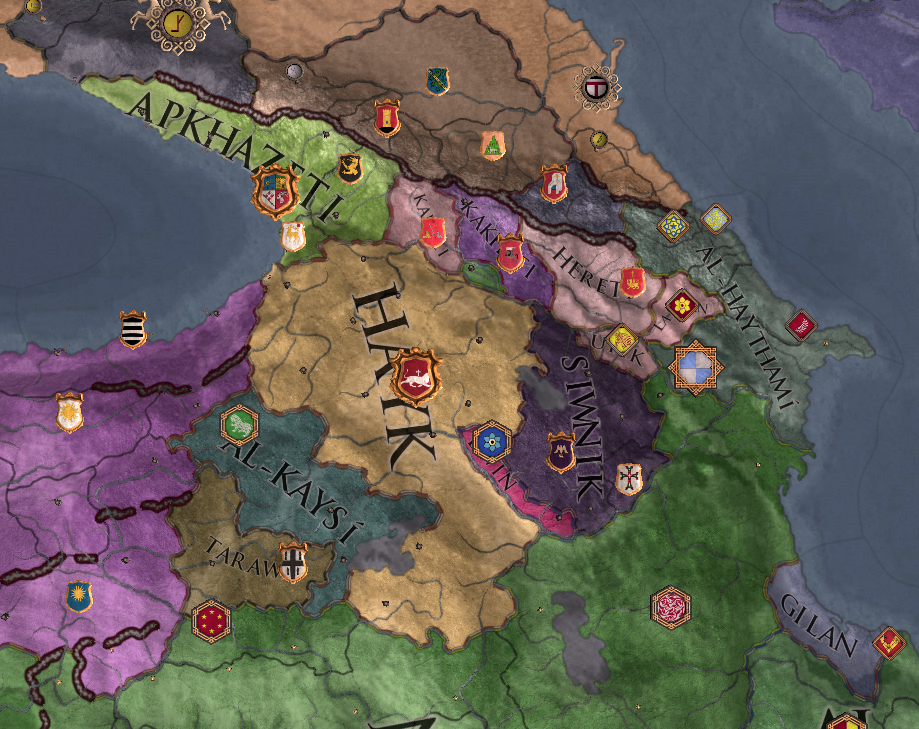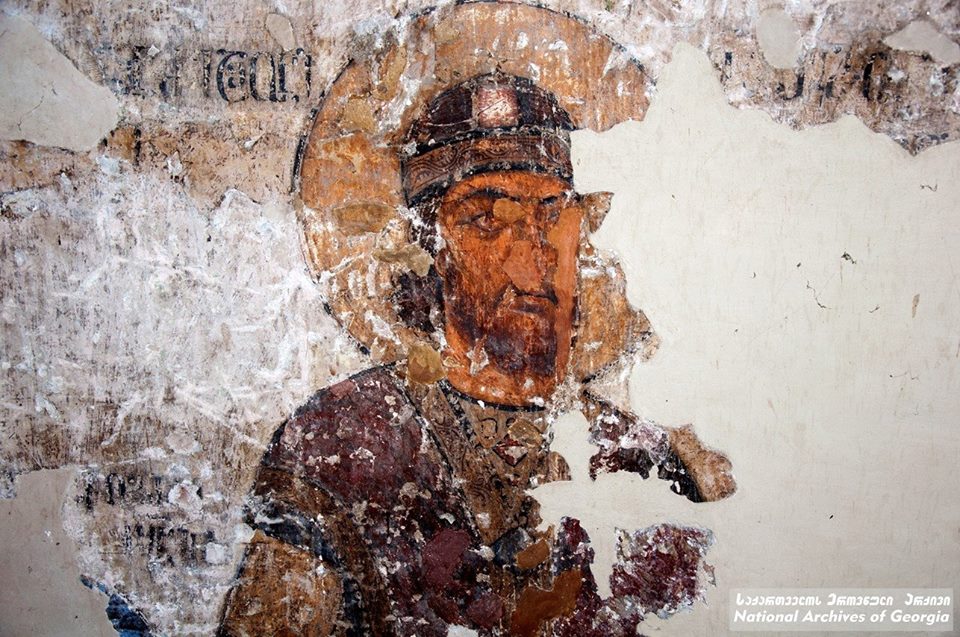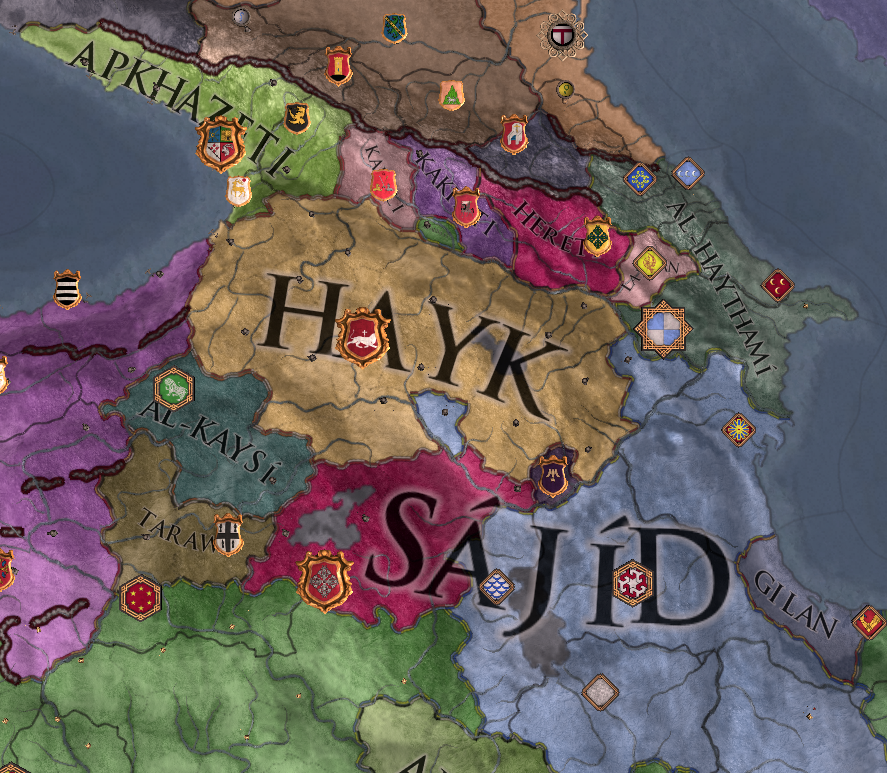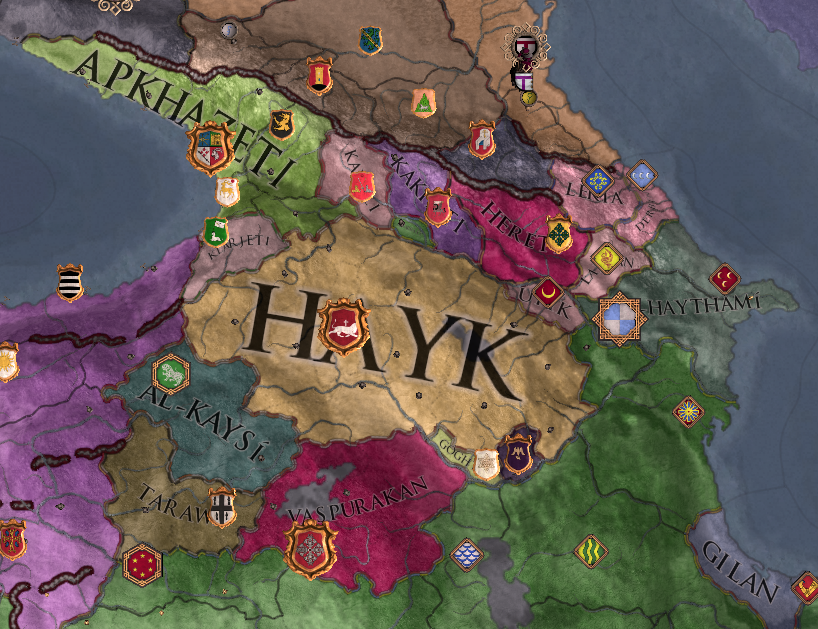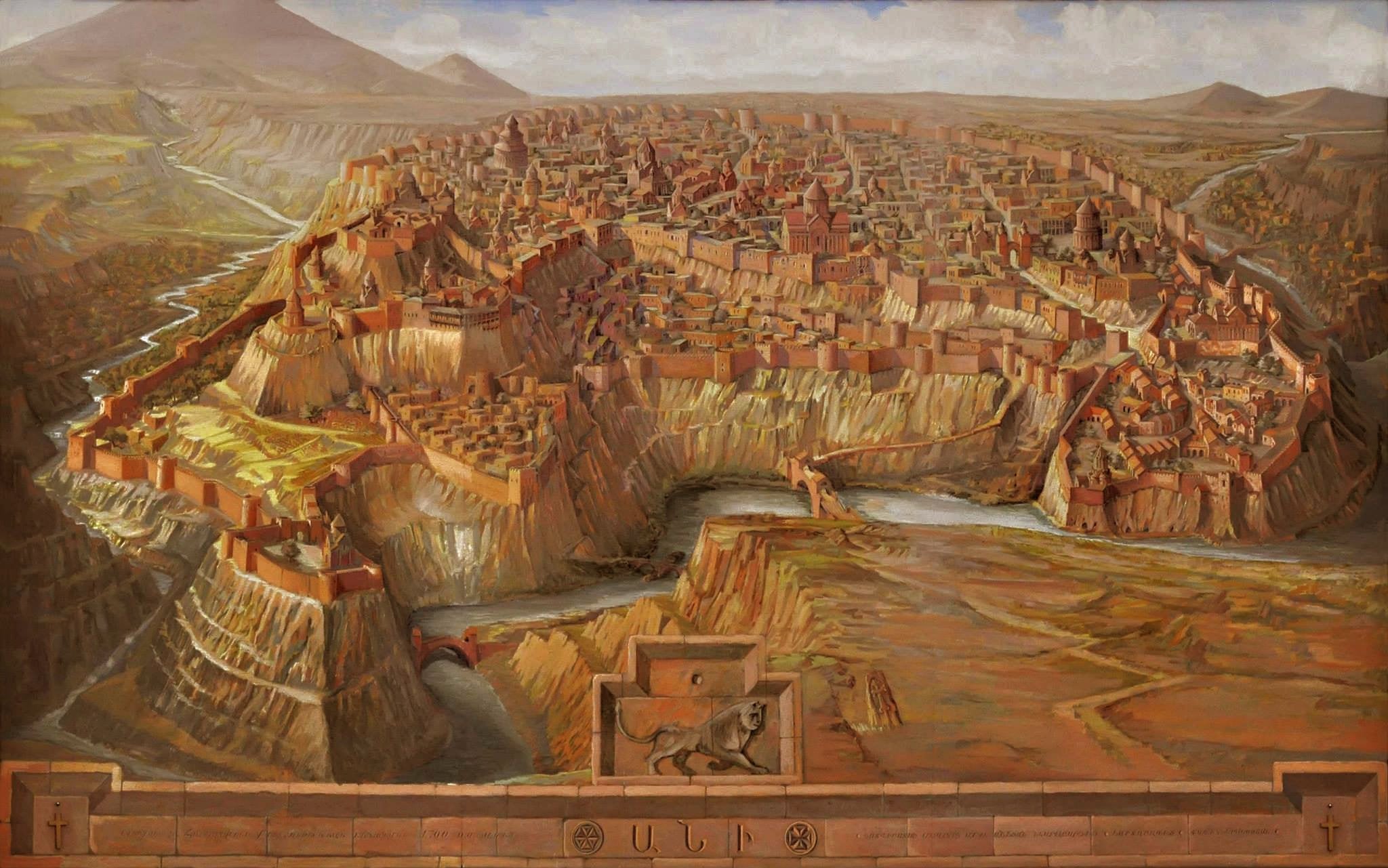Chapter 12 - The Last of the Armenians (1055-1063)
As the year 1055 came to a close, Court Chaplain Manuel burst through the doors of Gagik's court, screaming about his unfaithful kin who had abandoned the Church and turned towards Rome. Sub-King Gagik-Abas of Vanand, always a conniving man, had married Maria off to the de Hauteville Normans of Southern Italy, hoping to form an alliance and wrestle the throne of Ani from King Gagik. His plans never amounted to much, for no one among the
Naxarar dared revolt against the popular King Gagik II, even if they had grown weary of the constant warfare.
Spending over a decade in Sicily prior to her ascension to the throne of Vanand, Maria had adopted the faith of her Norman husband. With her new faith, Maria's allegiance was to Rome and her husband, always quick-witted, Chaplain Manuel wished to have her deposed, bringing down the hammer of the Inquisition upon Maria and her followers.
The Catholic Sub-Queen of Vanand
While her turn of faith and conspiring was unacceptable to the King, he hoped to avoid making new enemies, especially as his armies were on the way to Lori, capital of the treacherous King Davit. While the vast majority of Davit's subjects were now Georgian, the center of his power still remained in Lori and Gardman, by far the most populous of his provinces and populated by Armenians. If Gagik were to retake Lori, Davit would have to move his court from his capital to a more removed and safe province to the North, where the Georgian nobility was less fond of him, vastly weakening his authority and support from his Armenian followers.
The Kings of the Caucasus, January of 1056
Despite the numeric superiority and vast difference of skill between Gagik and Davit, the Georgians proved resilient, enduring many losses to Gagik and his men. The mountainous terrain of Davit's Kingdom only complicated things further, giving Gagik a taste of his own medicine, for all his previous enemies had struggled trying to attack Armenia. Now he was in their place.
Some of the battles that took place during the "War of Caucasian Hegemony" as it would come to be known by Historians
Lori fell quickly to the Armenians forces as its proximity to Ani made it easy to resupply the besiegers, leading to a rapid capture and re-establishment of Armenian rule. While the local nobles were avid supporters of Davit, the common folk adored Gagik and viewed him as their liberator. The following months however would follow an arduous campaign of guerrilla warfare as the Georgians entrenched themselves in their mountainous fortresses, autonomously defending their lands as Davit scrambled from city to city trying to reassert his already low legitimacy among them. He would ultimately surrender Lori to King Gagik in April of 1057, ending the 16 month-long war against Armenia.
Armenia in April of 1057
The following years would be a tumultuous time for the Kingdom of Armenia, with Georgia in shambles following Gagik's triumph over Davit, there was little to stop the steppe warriors to make the trek down to the prosperous provinces of Armenia, where they would raid and pillage the many rural towns and villages dotting the landscape. Initially, these raids would be made by small raiding parties of less than five hundred men, allowing for easy retreats by these mounted warriors if they spotted Gagik's forces heading to defend.
The first of many nomad incursions into Armenia
While they rarely ventured into Armenia proper at first due to the vast amount of fortifications and militancy of its people through the Church, the provinces of Shirvan were heavily targeted by these nomads, inciting many rebellions by the Muslim inhabitants who felt Gagik was not doing enough to protect them.
Just one of many Muslim rebellions to occur as the nomads caused unrest across Shirvan
Despite the growing unrest across the Kingdom, Gagik refused to stop his campaigns, outright ignoring the counsel of his generals who advised him to first secure the stability and defense of the realm before attempting to expand, especially as the power of the Seljuks grew. In the event of an invasion by these Turks, Armenia would have to be stable and united if they hoped to defeat their onslaught.
The pressures of ruling a vast realm were getting to Gagik...
Ignoring the objections by the High Council, his subjects, and even Queen Mara, the King declared war on Emperor Leon VII, who according to some rumors, had recently announced a new campaign to retake Armenia as his predecessors had attempted in the past. Leon, just like King Gagik, carried the blood of the legendary Bagrat, founder of the Bagratid dynasty, making him his kin in a distant way. As his paranoia and stress got the better of him, Gagik started seeing Leon as a danger to his reign, for Leon could easily stake a claim on the throne due to his blood. Not willing to wait for the Emperor to strike first, Gagik made his move, hoping to retake Vaspurakan to the South.
Emperor Leon VII, May of 1059
These rumors were of course, largely false, as Emperor Leon was far more worried on keeping the stability of his realm and putting down the many rebellions that plagued it. King Gagik would face no opposition from the Greeks for over a year, allowing him to easily retake Vaspurakan. The armies of Leon would arrive in June of the following year, proving largely unsuccessful to obtain the support of the populace who felt "liberated" by Gagik.
Emperor Leon arrives in Vaspurakan, June of 1060
It had been around that the Gagik's fortune took a turn for the worse, gravely falling ill of the Flu. Some claimed the constant battling of his had weakened his body, allowing the illness to invade his defenseless body, others said that it was the pressures of leaving Ani as the nobles and subjects grew restless, conspiring against his regime. Regardless, Gagik was far too weak to effectively lead his armies into battle, leaving the command of his armies to his generals, who in his paranoia he started to consider disloyal, even blaming them for his illness.
Wanting to retake command of his troops as soon as possible, fearing they could grow loyal to their generals instead of him, Gagik brought over many physicians and doctors from across Vaspurakan to his tent. From leeches and potions, to cold showers and sunbaths, nothing proved effective. Always a cynic, the King even turned to God, visiting a nearby monastery hoping some prayer could aid him. Nothing seemed to work. It would take a strange man named Aboulgharib, a well-travelled Armenian physician who claimed to have worked for countless kings and monarchs of the far East for years, to cure his disease. Carrying with him a strange bag full of brightly colored powders said to have originated in the Indies, Aboulgharib brewed a remedy for Gagik on the innards of a rabid animal. While the other physicians urged Gagik to refuse the treatment by the strange man, he refused to listen to their counsel as they had failed to cure his illness.
Aboulgharib's remedy was the work of miracles! Gagik was finally able to stand, getting up from his bed and marching into his camp. Feeling invigorated by the strange potion, Gagik once more took command of his armies and marched towards the Imperial forces near Bznunik. As his men clashed unto Leon's, King Gagik suddenly felt fatigued, unable to keep up with even the lowest skilled of his men. Out of breath and with his heart racing, he was spotted by one of the Emperor's commanders, Arngrimr of the Varangian Guard. King Gagik had never lost a battle, let a lone a duel, in his life, but he briefly saw his life flash before his eyes as the Northman stroke his face with the pommel of his sword. Had Gagik not been a second quicker, Arngrimir might not have slipped as his leg was sliced, able to slice Gagik's head instead.
The King laid on the ground, exhausted from the duel. He had nearly been killed and it seemed the miracle potion was but a temporary measure, once again feeling the Flu spreading through his body, but this time with a vengeance. Shocked by the sight of their King on the ground, he was swiftly carried out of the battlefield by his men as they mounted a retreat back into Vaspurakan. Emperor Leon had brought about King Gagik's first defeat, bringing an end to the appearance of invincibility the Armenian King previously possessed.
The Battle of Arceš, July of 1060
The defeat at Arceš sent shock waves throughout Armenia and the neighboring realms, forcing even his most staunch of supporters to turn his back on the King. The
Naxarar rose up, refusing to send any more of their men to Vaspurakan, seizing the capital from Gagik's retinue. Queen Mara and the princess managed to escape the assault on Ani, but were captured a few months later as they attempted to hide in the mountainside.
The rebel forces during the Sack of Ani, August of 1060
With his forces demoralized following the defeat, and no reinforcements on the way, many of Gagik's men started to desert the camp as the king fell further into decline as the sickness took a hold of his body. Despite this, the King refused to go home, hiring the services of foreign mercenaries for the first time, something he had loathed in the past and which his previous enemies were known for. A lot of firsts for Gagik and Armenia during these last few years.
The Alan Riders join the fray
Led by the imposing Dzæræs of Alania, these Alan riders' mastery with the bow and arrow would greatly bolster the ranks of Gagik's army, allowing him to triumph over the Greeks in the subsequent Battle of Khlat as they had not expected the change of tactics the Alan mounted archers had brought to the Armenian army.
Dzæræs' victory over Emperor Leon, November of 1060
Shortly after the victory at Khlat, Gagik managed to defeat his battle against the Flu, fully recovering once more. His encounter with the Varangian had too healed, although it had left him scarred on the face.
Emperor Leon had heard of the unrest occurring in Ani and initially thought victory had come to the Empire, for Gagik would be forced to return to withdraw from Vaspurakan to bring down the rebels. After his loss at Khlat these hopes were dashed as Gagik prepared to pursue his defeated army. Cursing the madman, Leon agreed to surrender the province of Vaspurakan to Gagik preferring to avoid any more bloodshed, saving his manpower for the wars that truly mattered in the Balkans. This proved to be a wise choice, for what little remained of Vaspurakan was in flames following the months of heavy campaigning by both parties.
Exhausted by the campaign against Leon, the Armenians were ready to return home to their wives and children. This of course would not be the case as they would have to retake Ani first. King Gagik dreaded of what would happen once his armies reached Ani, for his weathered soldiers would likely refuse to engage on his fellow Armenians who had taken the city. Thus he was relieved when he received an envoy announcing an invasion of Armenia by the Rawwadid Emirate.
Emir Menûçihr of the Rawwadid Emirate
Some of Gagik's men that had deserted months earlier would once more march South hoping to rejoin Gagik's forces to fight off the invaders, for they knew only his leadership could beat them back. Initially reluctant to accept these "traitors," as he called them, Gagik eventually would allow them to join his forces once more.
The Kingdom of Armenia and the Rawwadid Emirate (in red), July of 1061
With these new recruits Gagik moved to the outskirts of Arran, sending an envoy to his nephew Fezl asking for assistance. The envoy never returned, preferring to stay in the safety of Fezl's court after he refused his uncle's call to arms. Despite his nephew's betrayal, King Gagik was able to beat back an incursion into Arran by Menûçihr.
The Battle of Barda'ah, September of 1061
The Armenians would then pursue the Emir's forces back to Tabriz, laying a successful siege to his capital, massacring the population. During the assault, Gagik managed to capture the Emir's brother and his daughter, which he hoped would bring Menûçihr to his knees.
The Siege and Massacre of Tabriz, December of 1061
Knowing of the unrest in Ani, the Emir knew Gagik could not support his campaign for much longer, attacking him continuously to chip away at his forces. Cut off from his capital, it was only a matter of time before the Armenian army was depleted, while the Rawwadid coffers could afford to hire mercenaries to replenish his losses.
Largely unsuccessful due to Gagik's prowess in combat, the Emir of Tabriz devised a new plan to defeat Gagik. He would send a few of his men to Ani, hoping to establish relations with the rebel forces whom they shared a common enemy with. If he could get the rebels to cooperate against Gagik in battle, both parties would achieve their goals. This diplomatic mission however was intercepted by Gagik near Vaspurakan, who swiftly defeated them, thwarting their attempts.
That same month, the Seljuk Sháhansháh Tughril-Beg, who Gagik had fostered friendly relations with, passed away, leaving behind the capable Baybars on the reigns of his vast empire. Some of his followers however, were unhappy with his ascension to the throne and supported his cousin Muhammad instead. Wanting to avoid a full-blown civil war, Baybars granted Muhammad control over a large portion of the Seljuk armies, asking him to instead of splitting the realm in half, he would go on to forge his own Empire as their predecessors had done.
The new Seljuk Emperor and his ambitious cousin Muhammad
With the threat of his cousin appeased, Baybars would go on to launch an invasion of the Byzantine Empire, hoping to end Greek rule in the Levant. With the East being populated by Islamic Indian Kingdoms, and the Northern steppes a wasteland compared to the riches of the cities in Persia, Muhammad and his men marched toward Armenia, declaring war on the small sub-kingdom of Queen Maria.
Muhammad's invasion of Vanand, December of 1062
Knowing full well the treacherous nature of Maria, as well as realizing that Vanand would only be a stepping stone on the conquest of Armenia by the Seljuk forces, agreed to her call of arms, hoping to stop Muhammad before he could enter the borders of Armenia. Shortly after the Seljuk invasion of Gagik's kingdom was announced, Menûçihr would withdraw his forces from Armenia, wishing to not upset Muhammad for attempting to conquer his soon-to-be lands.
With only Muhammad to worry about now, Gagik left Tabriz toward the city of Salmas, where he hoped to defeat the Seljuk Horde. Being outnumbered nearly 6 to 1, the Armenians prepared for the battle of their lives. If they failed, the gates of Armenia would be open, and with the Kingdom in chaos following the sack of Ani, it would surely fall to the invaders. Even with Gagik's prowess for battle, the odds were not in their favor.
The Battle of Salmas, January of 1063
As the ground shook beneath their feet, his men thought an earthquake was occurring, as if the gates of hell itself were opening. Then, came the thunderous scream of over ten thousand warriors, which some say could be heard all the way to Constantinople. As their eyes laid sight on Muhammad's army, the Alans deserted Gagik, but not before raiding his camp of supplies and what little gold he had remaining. The smells of vomit and urine would soon make their way to the King's nostrils as his men quivered with fear at the incoming riders. Some attempted to flee, but were reluctantly shot by Gagik's archers. Others refused to pick up their swords, instead kneeling to pray one last time before meeting with their maker. As the guttural sounds of the enemy riders grew closer, everything went dark as the Armenians drowned in a sea of death.
Only the King would be spared, as he was quickly captured during the battle. Always cruel, Muhammad preferred him alive, wanting him to observe as his kingdom crumbled at the might of his ruthless horde, slowly seeing his life's work vanish right before his eyes.
Powerless to stop them, Gagik watched as Muhammad's horde disappeared on the horizon, riding North toward his Kingdom. He would be found an hour later, passed out and shivering uncontrollably. It seemed brewing remedies inside the corpses of rabid animals had not been a wise choice, for Gagik was diagnosed with rabies. His flu had also returned once more, destroying what little defenses his body could have against the new disease.
He returned to Vaspurakan, demanding that Aboulgharib fixed what he had caused him. The physician attempted many experimental treatments, each one riskier than the last. The bees seemed to sedate the King enough to perform surgery on him. Gagik tried to refuse the madman's treatment, but was far too weak and could not fight back. Losing much of the tissue formerly known as his face, as well as one of his eyes, Gagik was left a broken mess of a man, dying three days later.


